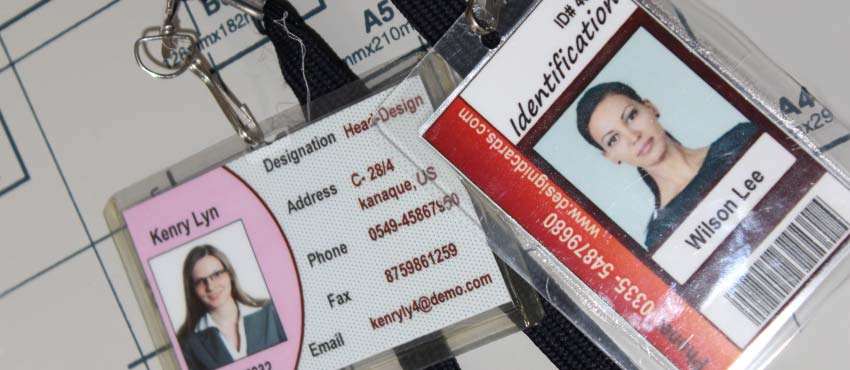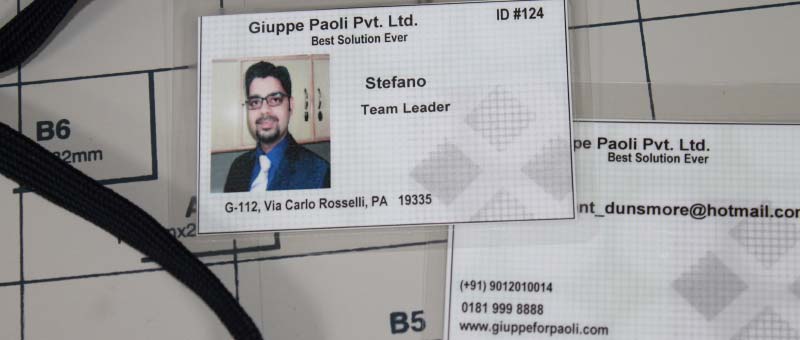ID Badge Holders Available
ID badge holders come in a variety of styles and designs, each offering unique features and functionality. Here are some of the most common types of ID badge holders available:

-
Vinyl Badge Holders: Vinyl badge holders are the most popular and widely used type. They are transparent plastic sleeves that securely hold the ID card. Vinyl holders typically have a slot or two holes at the top for attaching lanyards, badge reels, or clips. They come in various sizes, including vertical and horizontal orientations, to accommodate different card dimensions.
-
Multi-card Badge Holders: Multi-card holders are ideal for situations where individuals need to display multiple ID cards, such as an access card, a proximity card, and a photo ID card. These holders have multiple slots or compartments to accommodate several cards in one holder. They often come with adjustable or rotating clips that allow easy display and access to the required card.
-
Hard Plastic Badge Holders: Hard plastic badge holders provide additional protection for the ID card. They are made of rigid plastic that shields the card from bending, cracking, or getting damaged. Hard plastic holders often have a thumb slot, making it easier to slide the card in and out. They also feature attachment options for lanyards, reels, or clips.
-
Arm Band Badge Holders: Arm band badge holders are worn around the upper arm, making them ideal for situations where wearing a lanyard or attaching the badge to clothing is impractical. These holders typically have an adjustable elastic or Velcro strap that fits comfortably around the arm, with a transparent window to display the ID card.
-
Proximity Card Holders: Proximity card holders are designed specifically for access control cards or proximity cards that use RFID or NFC technology. These holders have a special cutout or transparent area on one side to allow the proximity card to be scanned or tapped against a reader without removing it from the holder. This convenience allows employees to easily access secured areas without the hassle of constantly removing their cards.
-
Badge Reels: Badge reels are retractable holders that allow the ID card to extend and retract easily. They consist of a reel mechanism attached to a clip or a pin-back attachment. The retractable cord or chain can extend several feet, allowing users to swipe or scan their cards without removing them from the holder. Badge reels are popular in environments where frequent card use is required, such as office buildings or parking lots.
-
Secure Badge Holders: Secure badge holders are designed to prevent unauthorized removal of the ID card. They have additional features such as a zip-lock or snap closure to seal the holder, protecting the card from accidental loss or theft. Some secure holders may also have a rigid backing or locking mechanisms to ensure the card remains securely in place.
-
Magnetic Badge Holders: Magnetic badge holders use magnets to attach the ID card to clothing. They have a magnet on the back of the holder that securely holds the card in place, eliminating the need for clips or pins that may damage clothing. Magnetic holders are convenient and easy to use, but they may not be suitable for individuals with pacemakers or sensitive electronic devices.
Create Custom ID Badge Designs
You can create custom ID badge designs. There are several steps involved in the process, which I'll explain in detail. By following these steps, you can create custom ID badge designs that align with your organization's requirements and branding while effectively serving their purpose.

-
Determine the Purpose and Requirements:
Start by clarifying the purpose of the ID badges and identifying any specific requirements. Consider factors such as the organization's branding guidelines, information to be displayed on the badge (e.g., employee name, photo, job title, logo), and any security features needed (e.g., holograms, barcodes).
-
Design Layout:
Start by creating a layout for your ID badge. Determine the dimensions of the badge based on your requirements and any existing badge holders or lanyards. Typically, ID badges are rectangular in shape, with dimensions around 2.13 inches by 3.38 inches (54 mm x 86 mm), similar to a credit card.
-
Choose a Design Software:
To create custom ID badge designs, you'll need design software capable of handling graphics and layout. Popular options include Adobe Photoshop, Adobe Illustrator, CorelDRAW, or even online tools like Canva. Select a tool that you're comfortable using and that offers the features you require.
-
Customize the Design:
Use the design software to customize the appearance of your ID badge. Consider incorporating your organization's branding elements such as logos, colors, and fonts. Ensure that the design is visually appealing, legible, and aligned with the overall look and feel of your organization.
-
Add Information:
Include the necessary information on the badge, such as the employee's name, photo, job title, and any additional details required by your organization. Pay attention to the font size, readability, and placement of each element to ensure clarity.
-
Consider Security Features:
If your organization requires security features, you can add elements like holograms, barcodes, QR codes, or magnetic stripes to the ID badge design. These features can help with access control, tracking, or authentication.
-
Review and Proofread:
Before finalizing the design, thoroughly review the ID badge layout and information. Check for any errors or inconsistencies in the design, spelling, or information provided. It's crucial to ensure accuracy before moving forward.
-
Test and Evaluate:
Once the ID badges are printed and produced, test them to ensure that they meet your expectations. Check for any printing issues, color accuracy, or other quality concerns. Seek feedback from users and make any necessary adjustments for future iterations.
Remember to comply with any legal or organizational regulations regarding ID badges, such as privacy guidelines and data protection laws. Additionally, consider any safety measures for ID badges, such as using non-toxic materials or incorporating safety features to prevent misuse.